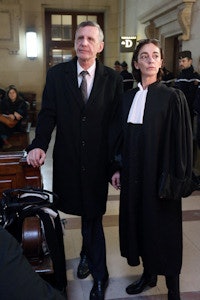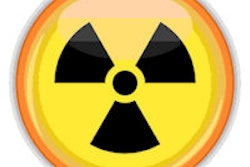
Three doctors at a hospital in northeastern France have been convicted of manslaughter and serious injury because of radiation overdoses between 2001 and 2006 that affected 450 prostate cancer patients. The incidents led to the deaths of at least 12 patients and resulted in serious injury to many others.
The overdoses at Jean Monnet Hospital in Epinal, Les Vosges, resulted from two key errors, the judge in the case summed up last week in Paris after a four-month hearing. One of the mistakes concerned incorrect technical calibration in radiation therapy machines during installation in 2004, and the second stemmed from human error, namely not factoring into the final calculation the radiation dose that patients received during radiological exams prior to treatment in procedures that took place between 2001 and 2006.
 Dr. Michel Aubertel waits for the verdict in Paris. Image courtesy of Agence France-Presse/Getty.
Dr. Michel Aubertel waits for the verdict in Paris. Image courtesy of Agence France-Presse/Getty.
The convictions have yet again highlighted the importance of radiation dose awareness, not only for patients but also for healthcare providers. One of the defendants, Dr. Joshua Anah, was sentenced to a fixed prison term of 18 months, a fine of 10,000 euros ($13,600 U.S.), and a five-year ban on practice. Meanwhile, his colleagues, cancer physicians Dr. Jean-Francois Sztermer and Dr. Michel Aubertel, were given fixed sentences of 18 months, fines of 20,000 euros ($27,000 U.S.), and lifelong bans from practicing medicine.
According to published reports, at least 24 patients received a 20% radiation overdose between May and August 2005 due to erroneous calibration of new radiation therapy machines, while failure to take into account radiation dose from previous imaging procedures led to overdoses of between 8% and 10% across 424 other patients between 2001 and 2006.
Besides the 12 fatalities, the overdosing has caused serious urinary and digestive problems and sexual dysfunction among many of the affected patients. Anah admitted to negligence in the calibration of the machines and failure to correctly train technicians in using them. His suspended three-year sentence included the charges of manslaughter and destroying evidence, while the other two doctors were each given four-year suspended sentences that recognized manslaughter, unintentional injury, and failing to help people in danger.
According to the French Society of Oncologic Radiotherapy (Société Française de Radiothérapie Oncologique [SFRO]), two-thirds of cancer patients are treated with radiotherapy at some stage of their disease, representing 200,000 treatments in France per year, equating to about 4 million sessions. Of those patients cured of cancer, 40% owe this outcome to radiotherapy, according to the SFRO.
In a statement shortly ahead of the opening of the court case in September 2012, SFRO said strict measures were in place to prevent treatment errors, and these had been reinforced since 2006 through an increase in full-time radiotherapy staff to 530 in 2011, compared with 350 in 2006. The number of posts is set to increase in 2013 and 2014, according to SFRO.
In addition, radiotherapy quality assurance staff were established in 140 centers across France in 2011 and 2012 to improve the dissemination of radiotherapy safety awareness and practice through ensuring the application of QA measures.
Finally, the creation of an early signaling mechanism to l'Autorité de Sûreté Nucléaire (French Nuclear Security Authority) and the French medical regulatory agency, Agence Française de Sécurité Sanitaire des Produits de Santé (French Agency for the Safety of Health Products [AFSSAPS]), for unexpected adverse events both within a service and at a national level mirrored the amplification of a "culture of safety" that already existed in many radiotherapy centers before 2006, according to the society, and this culture would continue to strengthen through ongoing professional training for all radiotherapy staff.



















